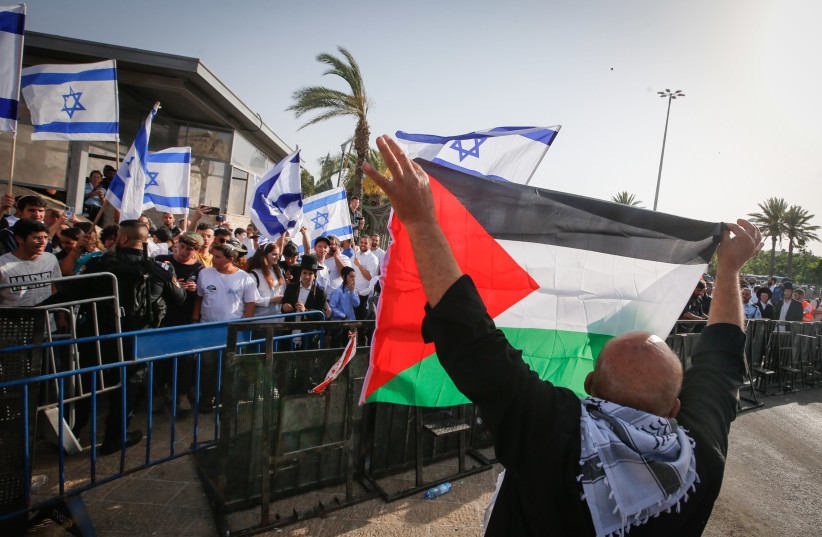The annual Flag March that takes place on Jerusalem Day proceeded in the late afternoon and into the evening on Sunday as police tried to maintain law and order and keep clashes from taking place. In recent years, this march has become a lightning rod for tensions and Palestinian groups like Hamas try to exploit it so as to create an excuse for conflict. At the same time, far-right Israeli religious youth sometimes come to Jerusalem to cause trouble, chant anti-Arab songs and vandalize Arab shops, looking for a fight.
This is the context under which I went to the march as I have in years past, to cover what might happen. Last year the Flag March took place amid the tensions that led to ten days of fighting between Israel and Hamas. This year there were concerns about violence as well. It also came in the wake of the killing of journalist Shireen Abu Akleh and the controversy over police handling of the funeral in Jerusalem.
Today the march took place down Jaffa Street as tens of thousands gathered in the afternoon. They came to the city from all over. Most were visibly national-religious youth, often coming in groups aboard buses. However, others gathered as well, including Haredi youth and some secular Israelis. Many of the younger people seemed to come for the spectacle and fun of the events. There was a kind of live concert at Army square next to New Gate. Youth, in their young teens, took the chance to drag on cigarettes and flirt. Someone had distributed shirts that showed an M-16 and a Star of David, adding to the far-right feeling that one gets at these marches. This mix of nationalism and some youth looking for fights and clashes; with those who come to celebrate the unity of Jerusalem and sing songs, is always one of the main problems with this day. It can’t pass without those who want to create tensions and violence.
I walked down Jaffa and then up to Neve’im street. That street was almost deserted, a testament to how well police had cordoned off traffic and how those who came for the march were routed down Jaffa street and then funneled into Damascus Gate. That funnel was achieved through layers of Border Police and security who kept Arabs and Jews separated in areas where they otherwise might walk past each other, such as entering Damascus Gate. Arab-owned shops were closed. Residents of the Old City were told to stay home and police seemed to be stationed at the entrance to every alley leading to Arab homes.
In addition, police kept the Jewish marchers on their route. Roadblocks and fences were put up along Route 1 so that there could be no error. Whenever stragglers went off the route they were told to go back or it was made clear they could not enter east Jerusalem. Overall this seemed to be successful.

The Old City
I walked into Damascus Gate, remembering the clashes of the past when police would fight with Arab protesters. But today there was no tear gas or flashbang grenades. The marchers crowded into the gate, where video showed there had been some scuffles earlier. Some teens took it upon themselves to slap stickers with the Israeli flag on shops, and even on the sign of the Austrian Hospice. Some tried to damage the locks of Arab-owned shops. Others told them to stop the vandalism. An older couple, chatting with one of the policemen from the Yasam elite police unit said how in decades past this march had proceeded without the need for so many police to secure it. Indeed, as they discussed how things had changed, it was clear how this march had become so heated and controversial. Extremists have taken advantage of it, but so have Hamas and others who seek to prevent it from taking place.
I rested near a large historic pillar outside the Armenian Catholic Patriarchate. The pillar was still warm from the day’s heat. A light breeze was blowing. Here along these steps are some of the holy sites of Christian worshipers and pilgrims. This is part of the Via Dolorosa and some of the Stations of the Cross are here. That means that these sites commemorate religious events of 2,000 years ago, and yet here we are with a march that goes along part of the same route and commemorates not only the ancient heritage that Jews have in Jerusalem but also the victory of 1967.
The crowds surged into this square as they moved toward the Western Wall. Some Yeshiva students gave out water and cleaned up the mass of plastic cups they had given out. Wave after wave of youth came singing songs. An older Arab man who needed to get home asked the police if they could walk him to his door. He was worried about the crowds of youth. The police obliged and took him across the road to his home. Down one deserted alley, two cats dug through some trash. They were all that moved in an Old City that was so eerily quiet in some areas, but so passionate, wild, chaotic and loud along the route of the march.
